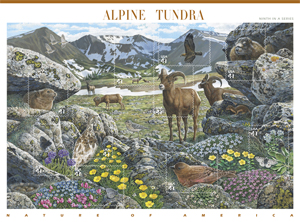
On Aug 28, 2007, Post Offices will be greener with the release of the Alpine Tundra stamps. The stamp pane consists of 10 stamps arranged in an imaginary setting at 12,000 feet in Rocky Mountain National Park. These beautiful stamps promote the appreciation of our major plant and animal communities in the United States and the ecological relationship between animals and plants. They suggest the biodiversity necessary to ensure the viability of that relationship.
Depicted on the Alpine Tundra pane are more than 24 animal and plant species by stamp artist John D. Dawson, in his beautiful acrylic painting. The scene itself is imaginary. Such a dense grouping of plants and animals was necessary to illustrate as many species as possible on the stamp pane. The plant and animal species were recommended by scientists.
This pane is the ninth in an educational series designed to promote appreciation of major plant and animal communities in the United States. Previous issuances in the Nature of America series were Sonoran Desert (1999), Pacific Coast Rain Forest (2000), Great Plains Prairie (2001), Longleaf Pine Forest (2002), Arctic Tundra (2003), Pacific Coral Reef (2004), Northeast Deciduous Forest (2005) and Southern Florida Wetland (2006).
Alpine Tundra Habitat
Alpine tundra begins above the tree line in high mountain areas. In this environment, snow covers much of the landscape until spring, and temperatures can be chilly even in summer. To survive here, plants grow close to the ground and have extensive root systems that absorb water, collect nutrients and anchor them against the wind. Only the hardiest animals live year-round on the tundra. In summer and fall they build up body fat and, in some cases, store food in dens or burrows. As the weather grows colder, thick fur or feathers help keep them warm. Some of the species hibernate through winter.
The stamp pane depicts a summer tundra scene about 12,000 feet in elevation in Rocky Mountain National Park in northern Colorado. Elk and bighorn sheep graze the open areas while smaller mammals — a pika, yellow-bellied marmot and ermine — stay close to the rocks, ready to take cover if threatened by a predator, such as the soaring golden eagle.
A white-tailed ptarmigan strolls near the rocks, feeding on flowers, leaves and insects. Now mottled grayish-brown, its summer plumage will soon give way to winter's white feathers. A pipit, named for its high-pitched pip-pip call, has built a nest in the shelter of the rocks. This bird will not stay through the winter. Instead, it will migrate to a warmer region. The brown-capped rosy-finch, in the foreground, will linger as long as possible, moving below the tree line when winter snows make seeds and insects impossible to find. In the air are horned larks, recognized by the black hornlike feathers on their heads and the high-pitched, tinkling notes of their songs. Meanwhile, butterflies flit about rockslides, rest on rocks and sip nectar from alpine flowers.
Wildlife not shown in the painting but also found on the alpine tundra include pocket gophers, coyotes and, occasionally, a black bear. Grizzly bears were hunted out of the area before it became Rocky Mountain National Park. They are found in some of the other alpine tundra areas of the West.
Alpine Tundra Species
The selvage — the decorative area around the stamps on the stamp pane — gives a description of alpine tundra, and a numbered key to the artwork appears on the back of the pane, along with a corresponding list of common and scientific names for 24 species.
1. Horned Lark Eremophila alpestris
2. Map Lichen Rhizocarpon geographicum
3. American Pika Ochotona princeps
4. Magdalena Alpine Butterfly Erebia magdalena
5. Sky Pilot Polemonium viscosum
6. American Pipit eggs Anthus rubescens
7. Alpine Forget-me-not Eritrichum aretioides
8. Dwarf Clover Trifolium nanum
9. White-tailed Ptarmigan Lagopus leucura
10. Elk (or Wapiti) Cervus elaphus
11. American Pipit Anthus rubescens
12. Alpine Avens Acomastylis rossii turbinata
13. Melissa Arctic Butterfly Oeneis melissa
14. Golden Eagle Aquila chrysaetos
15. Bighorn Sheep Ovis Canadensis
16. Yellow-bellied Marmot Marmota flaviventris
17. Ermine (Short-tailed Weasel) Mustela erminea
18. Alpine Phlox Phlox pulvinata
19. Buttercup Ranunculus sp.
20. Brown-capped Rosy-Finch Leucosticte australis
21. Alpine Spring Beauty Claytonia megarhiza
22. Moss Campion Silene acaulis
23. Rocky Mountain Parnassian Butterfly Parnassius smintheus
24. Mountain Candytuft Noccaea montana
Additional contact:
Al Desarro
303-313-5182
al.j.desarro@usps.gov
# # #
Please Note: For broadcast quality video and audio, photo stills and other media resources, visit the USPS Newsroom at http://about.usps.com/news/welcome.htm.
For reporters interested in speaking with a regional Postal Service public relations professional on this issue, please go to http://about.usps.com/news/media-contacts/usps-local-media-contacts.pdf.
A self-supporting government enterprise, the U.S. Postal Service is the only delivery service that reaches every address in the nation, 151 million residences, businesses and Post Office Boxes. The Postal Service receives no tax dollars for operating expenses, and relies on the sale of postage, products and services to fund its operations. With 32,000 retail locations and the most frequently visited website in the federal government, usps.com, the Postal Service has annual revenue of more than $65 billion and delivers nearly 40 percent of the world’s mail. If it were a private sector company, the U.S. Postal Service would rank 35th in the 2011 Fortune 500. Black Enterprise and Hispanic Business magazines ranked the Postal Service as a leader in workforce diversity. The Postal Service has been named the Most Trusted Government Agency for six years and the sixth Most Trusted Business in the nation by the Ponemon Institute.
Follow USPS on Twitter @USPS_PR and at Facebook.com/usps.

